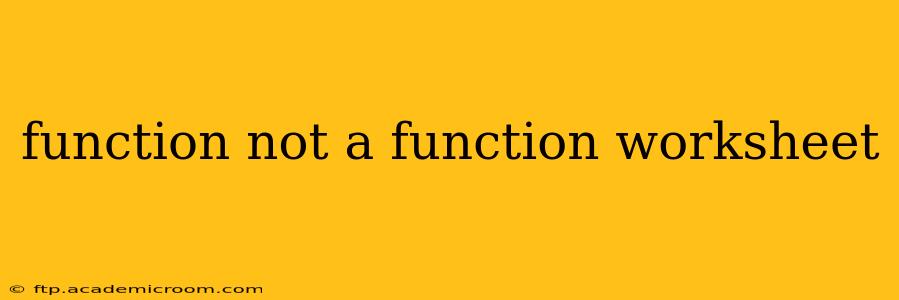Determining whether a relation is a function is a fundamental concept in algebra. This worksheet will guide you through various methods to identify functions, clarify common misconceptions, and build a strong understanding of this crucial mathematical concept. We'll explore different representations – tables, graphs, mappings, and equations – to solidify your grasp of the subject.
What is a Function?
A function is a relation where each input (x-value) has only one output (y-value). Think of it like a machine: you put something in, and it gives you one specific thing out. If you put the same input in twice, you must get the same output. If you get multiple outputs for a single input, it's not a function.
Identifying Functions Using Different Representations
Let's examine how to determine if a relation is a function using different methods:
1. Using a Table of Values
Example:
| Input (x) | Output (y) |
|---|---|
| 1 | 2 |
| 2 | 4 |
| 3 | 6 |
| 4 | 8 |
Analysis: Each input (x-value) has only one corresponding output (y-value). This is a function.
Example (Not a Function):
| Input (x) | Output (y) |
|---|---|
| 1 | 2 |
| 2 | 4 |
| 2 | 6 |
| 3 | 9 |
Analysis: The input x = 2 has two different outputs (4 and 6). This is not a function.
2. Using a Graph
The vertical line test is a powerful tool for identifying functions graphically. If any vertical line intersects the graph more than once, the relation is not a function.
Example (Function): A straight line (except a vertical line) always passes the vertical line test.
Example (Not a Function): A circle fails the vertical line test because a vertical line can intersect the circle at two points.
3. Using a Mapping Diagram
A mapping diagram visually represents the relationship between inputs and outputs. If any input has more than one arrow pointing to different outputs, it's not a function.
Example (Function): A clear one-to-one or many-to-one mapping represents a function.
Example (Not a Function): If one input maps to multiple outputs, it violates the function definition.
4. Using an Equation
An equation represents a function if for every x-value there is only one y-value. Sometimes, solving for y can help determine this. If you can solve for y and obtain more than one solution for a single x, it's not a function.
Example (Function): y = 2x + 1 (For every x, there's only one y)
Example (Not a Function): x = y² (For a positive x, there are two possible y values: a positive and a negative square root).
Frequently Asked Questions (FAQ)
Q: What's the difference between a relation and a function?
A: All functions are relations, but not all relations are functions. A relation is simply a set of ordered pairs. A function is a specific type of relation where each input has only one output.
Q: Can a vertical line be a function?
A: No, a vertical line is not a function. It fails the vertical line test because a vertical line intersects itself infinitely many times.
Q: How can I tell if an equation represents a function?
A: Try solving the equation for y. If you get more than one possible value for y for a given x, the equation does not represent a function. Alternatively, consider the graph of the equation; if it passes the vertical line test, it represents a function.
Q: Why is the vertical line test important?
A: The vertical line test provides a quick visual way to determine if a graph represents a function. It directly checks the one-output-per-input rule.
This worksheet provides a solid foundation for understanding functions. Practice with various examples and you will master this key algebraic concept. Remember, the key is that one input can only produce one output for a relation to be classified as a function.
